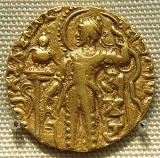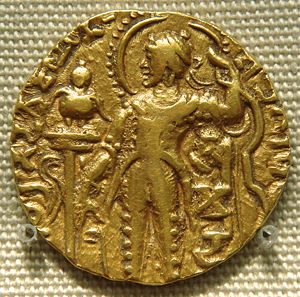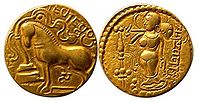
Samudragupta
Encyclopedia
Samudragupta ruler of the Gupta Empire
(c. AD 335 – 375), and successor to Chandragupta I
, is considered to be one of the greatest military geniuses in Indian history
according to Historian V. A. Smith. His name is taken to be a title acquired by his conquests (samudra referring to the 'oceans'). Samudragupta the Great is believed to have been his father's chosen successor even though he had several older brothers. Therefore, some believe that after the death of Chandragupta I
, there was a struggle for succession in which Samudragupta prevailed.
). In this inscription Samudragupta details his conquests. This inscription is also important because of the political geography of India that it indicates by naming the different kings and peoples who populated India in the first half of the fourth century AD. The inscription to Samudragupta's martial exploits states that its author is Harisena, who was an important poet of Samudragupta's court.

. He passed through the forest tracts of Madhya Pradesh
, crossed the Orissa
coast, marched through Ganjam
, Vishakapatnam, Godavari, Krishna
and Nellore
districts and may have reached as far as Kancheepuram. Here however he did not attempt to maintain direct control. After capturing his enemies he reinstated them as tributary kings. This act prevented the Gupta Empire from attaining the almost immediate demise of the Maurya Empire
and is a testament to his abilities as a statesman.
The details of Samudragupta's campaigns are too numerous to recount (these can be found in the first reference below). However it is clear that he possessed a powerful navy in addition to his army. In addition to tributary kingdoms, many other rulers of foreign states like the Saka
and Kushan kings accepted the suzerainty of Samudragupta and offered him their services.
 Much is known about Samudragupta through coins issued by him. These were of eight different types and all made of pure gold
Much is known about Samudragupta through coins issued by him. These were of eight different types and all made of pure gold
. His conquests brought him the gold and also the coin-making expertise from his acquaintance with the Kushana. Samudragupta is also known to have been "a man of culture". He was a patron of learning, a celebrated poet and a musician. Several coins depict him playing on the Indian lyre
or veena
. He gathered a galaxy of poets and scholars and took effective actions to foster and propagate religious, artistic and literary aspects of Indian culture. Though he favoured the Hindu religion like the other Gupta kings, he was reputed to possess a tolerant spirit vis-a-vis other religions. A clear illustration of this is the permission granted by him to the king of Ceylon to build a monastery for Buddhist pilgrims in Bodh Gaya.
Gupta Empire
The Gupta Empire was an ancient Indian empire which existed approximately from 320 to 550 CE and covered much of the Indian Subcontinent. Founded by Maharaja Sri-Gupta, the dynasty was the model of a classical civilization. The peace and prosperity created under leadership of Guptas enabled the...
(c. AD 335 – 375), and successor to Chandragupta I
Chandragupta I
The Gupta dynasty first seems to be in eminence with the accession of Chandra Gupta I, son of Ghatotkacha to the throne of the ancestral Gupta kingdom. While his two ancestors were given the title of Maharaja , Chandra Gupta I is described in his inscriptions as Maharajadhiraj signifying a rise in...
, is considered to be one of the greatest military geniuses in Indian history
History of India
The history of India begins with evidence of human activity of Homo sapiens as long as 75,000 years ago, or with earlier hominids including Homo erectus from about 500,000 years ago. The Indus Valley Civilization, which spread and flourished in the northwestern part of the Indian subcontinent from...
according to Historian V. A. Smith. His name is taken to be a title acquired by his conquests (samudra referring to the 'oceans'). Samudragupta the Great is believed to have been his father's chosen successor even though he had several older brothers. Therefore, some believe that after the death of Chandragupta I
Chandragupta I
The Gupta dynasty first seems to be in eminence with the accession of Chandra Gupta I, son of Ghatotkacha to the throne of the ancestral Gupta kingdom. While his two ancestors were given the title of Maharaja , Chandra Gupta I is described in his inscriptions as Maharajadhiraj signifying a rise in...
, there was a struggle for succession in which Samudragupta prevailed.
Sources
The main source of Samudragupta's history is an inscription engraved on one of the rocks set up by Asoka the Great in Kausambi (present day AllahabadAllahabad
Allahabad , or Settled by God in Persian, is a major city of India and is one of the main holy cities of Hinduism. It was renamed by the Mughals from the ancient name of Prayaga , and is by some accounts the second-oldest city in India. It is located in the north Indian state of Uttar Pradesh,...
). In this inscription Samudragupta details his conquests. This inscription is also important because of the political geography of India that it indicates by naming the different kings and peoples who populated India in the first half of the fourth century AD. The inscription to Samudragupta's martial exploits states that its author is Harisena, who was an important poet of Samudragupta's court.

Samudragupta's conquests
The beginning of Samudragupta's reign was marked by the defeat of his immediate neighbours, Achyuta, ruler of Ahichchhatra, and Nagasena. Following this Samudragupta began a campaign against the kingdoms to the south. This southern campaign took him south along the bay of BengalBay of Bengal
The Bay of Bengal , the largest bay in the world, forms the northeastern part of the Indian Ocean. It resembles a triangle in shape, and is bordered mostly by the Eastern Coast of India, southern coast of Bangladesh and Sri Lanka to the west and Burma and the Andaman and Nicobar Islands to the...
. He passed through the forest tracts of Madhya Pradesh
Madhya Pradesh
Madhya Pradesh , often called the Heart of India, is a state in central India. Its capital is Bhopal and Indore is the largest city....
, crossed the Orissa
Orissa
Orissa , officially Odisha since Nov 2011, is a state of India, located on the east coast of India, by the Bay of Bengal. It is the modern name of the ancient nation of Kalinga, which was invaded by the Maurya Emperor Ashoka in 261 BC. The modern state of Orissa was established on 1 April...
coast, marched through Ganjam
Ganjam
Ganjam is a town and a notified area committee in Ganjam district in the state of Orissa, India.-Geography:Ganjam is located at . It has an average elevation of 3 metres .-Demographics:...
, Vishakapatnam, Godavari, Krishna
Krishna district
Krishna District is a district of India's Andhra Pradesh state. It is named after the Krishna River, the third longest river that flows within India, flows through the district and joins Bay of Bengal here in this district. It has a population of 4,529,009 of which 32.08% is urban as of...
and Nellore
Nellore
Nellore , is a city and headquarters of Potti Sri Ramulu Nellore District, formerly Nellore district.And in the state of Andhra Pradesh. Ancient name of Nellore was "Vikrama Simhapuri"....
districts and may have reached as far as Kancheepuram. Here however he did not attempt to maintain direct control. After capturing his enemies he reinstated them as tributary kings. This act prevented the Gupta Empire from attaining the almost immediate demise of the Maurya Empire
Maurya Empire
The Maurya Empire was a geographically extensive Iron Age historical power in ancient India, ruled by the Mauryan dynasty from 321 to 185 BC...
and is a testament to his abilities as a statesman.
The details of Samudragupta's campaigns are too numerous to recount (these can be found in the first reference below). However it is clear that he possessed a powerful navy in addition to his army. In addition to tributary kingdoms, many other rulers of foreign states like the Saka
Saka
The Saka were a Scythian tribe or group of tribes....
and Kushan kings accepted the suzerainty of Samudragupta and offered him their services.
Patronage

Gold
Gold is a chemical element with the symbol Au and an atomic number of 79. Gold is a dense, soft, shiny, malleable and ductile metal. Pure gold has a bright yellow color and luster traditionally considered attractive, which it maintains without oxidizing in air or water. Chemically, gold is a...
. His conquests brought him the gold and also the coin-making expertise from his acquaintance with the Kushana. Samudragupta is also known to have been "a man of culture". He was a patron of learning, a celebrated poet and a musician. Several coins depict him playing on the Indian lyre
Lyre
The lyre is a stringed musical instrument known for its use in Greek classical antiquity and later. The word comes from the Greek "λύρα" and the earliest reference to the word is the Mycenaean Greek ru-ra-ta-e, meaning "lyrists", written in Linear B syllabic script...
or veena
Veena
Veena may refer to one of several Indian plucked instruments:With frets*Rudra veena, plucked string instrument used in Hindustani music*Saraswati veena, plucked string instrument used in Carnatic musicFretless...
. He gathered a galaxy of poets and scholars and took effective actions to foster and propagate religious, artistic and literary aspects of Indian culture. Though he favoured the Hindu religion like the other Gupta kings, he was reputed to possess a tolerant spirit vis-a-vis other religions. A clear illustration of this is the permission granted by him to the king of Ceylon to build a monastery for Buddhist pilgrims in Bodh Gaya.

